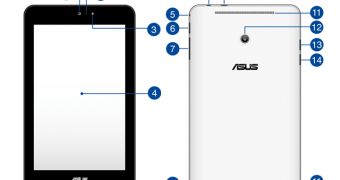Like any self-respectable tablet manufacturer, ASUS has been shown to be working on an 8-inch tablet offering of its own.
Competing companies like Acer (with its Iconia W4), Dell (with Venue 8 Pro), Lenovo (with IdeaTab Miix 2) and Toshiba (with Encore 8) all have 8-inch models available on the market, so it was just a matter of time before ASUS jumped onboard of the bandwagon, as well.
Recently, the existence of ASUS’s upcoming slate has been proved, as the device was spotted going through the FCC (with model number M80TA). Soon after that the tablet received a name, the VivoTab Note 8.
We have also seen some of its specifications being made available, but now ASUS has posted an official manual for the device, thus taking it out of the realm of speculation.
It has been speculated before that the M80TA might turn out to be a dual-OS kind of device capable of running both Windows 8 and Android, but the info in the manual shows this particular model will come shipping with Windows 8 out of the box.
On top of that, we also get the confirmation that the VivoTab Note 8 will definitely feature a smart pen, which was so far only a theory. The manual also reveals the Windows button will be located on the side of the tablet, just like we have seen with the Dell Venue 8 Pro.
As a round-up, the ASUS VivoTab Note 8 (M80TA) will come sporting an IPS 8-inch screen with a resolution of 1280 x 800 pixels and will draw power from an Intel Atom Z3740 quad-core processor (from the Bay Trail family) paired with 2GB of RAM and backed up by 32GB or 64GB of internal storage. The new device is expected to ship for $300 / €220 a pop.
An interesting matter that should be noted is the device list located in the EC Declaration of Conformity chapter, which mentions the M80T, L80T, R80T, M81T, L81T, R81T, M82T, L82T, and R82T models.
The FCC also acknowledged the tablet should become available in nine different models, so apparently the first three are Windows devices, the next are Android and the last three are dual-boot Windows/Android products.

 14 DAY TRIAL //
14 DAY TRIAL //